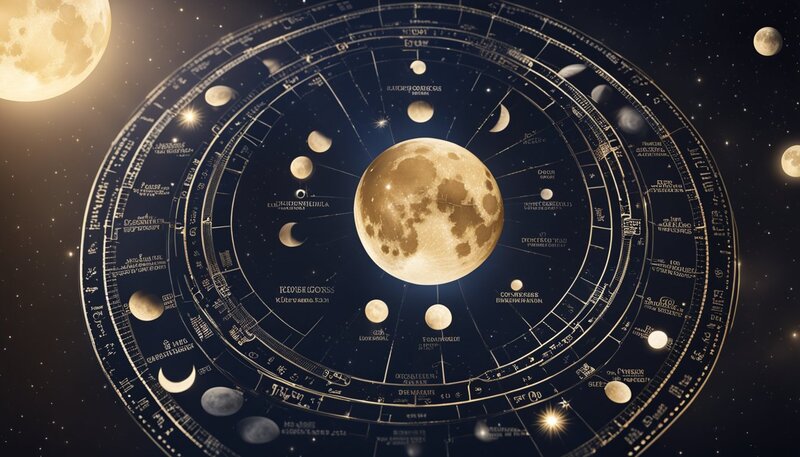Key Takeaways
- The moon’s phases reflect life’s cyclical nature and carry distinct spiritual energies.
- Aligning with lunar energies is seen as a pathway to personal growth and mindfulness.
- Astrology and various cultures ascribe unique significance to the moon’s influence.
Featured Partner Offer
1. Oranum Psychics

Gifted advisors
Free 9.99 Credits (with CC validation)
Reading Starts at 0.98 credits/m
100% Free Video Chat
2. Keen Psychics

Gifted advisors
Special Offer: 5 min for $1.00
Reading Starts at $1.99/m
Phone or Chat
Throughout history, the moon has maintained a mystical and influential place in human cultures, intertwining with our lives in both observable and subtle ways. Its ever-changing phases hold diverse meanings and significances that have been interpreted and reinterpreted across different cultures and spiritual practices. The moon’s cycle reflects the cycle of life, encompassing birth, growth, death, and rebirth, with each phase of the moon thought to carry its own spiritual energy and implications for personal growth and introspection.
Astrologically, the moon is linked to our innermost feelings and subconscious, shaping the ebb and flow of our emotional states and intuitive insights. Spiritual seekers and practitioners often align their activities and rituals with the lunar cycle, using the energetic qualities inherent in each phase to manifest intentions, effect personal transformation, and seek deeper harmony with the natural world. By observing the moon’s influence, one may embark upon a path of self-discovery and enhancement, correlating the phases with life’s rhythms and tides.
Understanding Moon Phases

The spiritual meanings attributed to moon phases are rooted in the lunar cycle’s influence on human introspection and cosmic energies. This section explores the significance of these phases and provides an overview from the New Moon to the Waning Crescent.
Significance of the Lunar Cycle
The lunar cycle comprises distinct phases reflecting the moon’s appearance from Earth as it orbits our planet. These phases exert varying influences, with many spiritual traditions suggesting they impact human emotion and behavior. For example, the full moon is often associated with heightened emotions and completion, while the new moon signifies new beginnings and intentions.
Overview of Phases: New Moon to Waning Crescent

New Moon:
The lunar cycle begins with the New Moon, which is not visible from Earth as the moon is between Earth and the sun. Spiritually, this phase represents a clean slate and is ideal for setting intentions.
- Waxing Crescent Moon: As a sliver of the moon becomes visible, goals and intentions start to take form.
First Quarter Moon:
At the first quarter, the moon is half illuminated. This phase symbolizes taking action, making decisions, and overcoming obstacles.
- Waxing Gibbous Moon: Refining and adjusting one’s approach is emphasized as the moon moves towards full illumination.
Full Moon:
The moon’s energy peaks at the Full Moon, illuminating the night sky completely. Emotionally and spiritually, it’s a time for reflection, release, and manifestation.
- Waning Gibbous Moon: After the full moon, the process of letting go and gratitude begins, appreciating the progress made.
Last Quarter Moon:
Representing release and forgiveness, the last quarter moon’s half illumination signals the time to let go of what no longer serves.
- Waning Crescent Moon: The final phase before the cycle restarts, the Waning Crescent, calls for rest, reflection, and the surrender of old ways in preparation for the renewal the next New Moon brings.
Spiritual Significance of Each Phase

The moon’s cycle has deep spiritual significance, from the introspective new moon to the reflective waning crescent. Each phase heralds a particular energy conducive to certain spiritual practices such as setting intentions, taking action, and releasing what no longer serves.
1. New Moon Spiritual Meaning
The new moon represents new beginnings and is a time to set intentions. It’s an ideal moment for reflection and contemplating future desires and goals. This phase is associated with darkness and potential, offering an opportunity to manifest new paths.
2. Waxing Crescent and Intention Setting
During the waxing crescent phase, energy builds towards future growth. It’s best to affirm one’s intentions and take small, practical steps towards them. This phase is a reminder that actions speak as loudly as intentions.
3. First Quarter Moon and Taking Action
The first quarter moon signifies a time for decisive action and overcoming obstacles. It is when intentions push into the external world, urging one to make meaningful progress towards their goals.
4. Waxing Gibbous Moon and Refinement
As the waxing gibbous moon increases in light, it illuminates the need for refinement and adjustment. This phase is about fine-tuning actions and ensuring they align with one’s intentions.
5. Full Moon Spiritual Meaning
The full moon marks a period of completion and celebration. It’s a time when emotions and intuition are heightened, and manifestations emerge. The full moon shines a light on what has been accomplished and what is still to be achieved.
6. Waning Gibbous Moon and Gratitude
The waning gibbous moon, sometimes known as the disseminating moon, invites gratitude and sharing of abundance. It is about recognizing the progress made and being thankful for the manifestation of intentions.
7. Third Quarter Moon and Release
With the third quarter moon, the focus shifts to letting go and release. It’s an opportunity to rid oneself of burdens and patterns that impede growth and transformation.
8. Waning Crescent Moon and Surrender
Lastly, the waning crescent moon symbolizes surrender and rest. This phase is a time to reflect on the cycle that has passed and prepare for the renewal that the next new moon brings. It’s about releasing control and embracing the wisdom of natural cycles.
Incorporating Spiritual Practices

Incorporating spiritual practices aligned with moon phases can deepen awareness and help individuals set powerful intentions. These practices may involve rituals, meditation, and journaling, each aligning with the lunar cycle’s influence on self-reflection and manifestation.
Moon Rituals and Ceremonies
Moon rituals and ceremonies offer structured actions to harness the moon’s energy. New Moon ceremonies, for example, are ideal for setting intentions, as the moon’s fresh cycle signifies beginnings. During the Full Moon, rituals often focus on gratitude and releasing what no longer serves, reflecting the moon’s illumination of life’s panorama. Participants may use a lunar calendar to plan their rituals appropriately and maximize the moon’s energetic potential.
- New Moon: Set intentions for the cycle ahead.
- Full Moon: Give thanks and release the old.
Related: How to make full moon water
Meditation and Reflection Techniques
Featured Partner Offer
1. Headspace AppFeatured
〉 Hundreds of meditation videos, breathing exercises, and podcasts
〉 Daily routines & schedules accessible on the app or website.
〉 Diverse Content for Every Mood
〉 Engaging and User-Friendly Interface
Meditation under the moonlight can be a powerful technique for enhancing self-reflection and manifesting desires. It’s a time to cultivate awareness and connect with the intuitive self. Meditation can focus on growth during the Waxing Moon, mirroring the moon’s increasing light. In contrast, the Waning Moon invites introspection and consideration of what one might let go.
- Waxing Moon: Meditate on growth and progress.
- Waning Moon: Reflect on release and surrender.
Journaling and Manifesting Desires
Journaling during different moon phases can facilitate the manifesting of personal desires. This act of writing helps crystallize thoughts and intentions. One might journal about new goals at the New Moon, while the Full Moon could prompt writing about accomplishments and recognitions. The practice should include specific, actionable steps that move one towards their intentions, encompassing both gratitude and acknowledgment of progress made.
- New Moon: Journal goals and new beginnings.
- Full Moon: Document achievements and lessons learnt.
The Moon’s Influence on Personal Growth

The moon’s phases offer a framework for personal reflection and progression. Each phase correlates with specific development themes, encouraging individuals to align their growth with the celestial rhythm.
Connecting with Natural Rhythms
In harmony with the moon’s cycles, individuals may sync their own cycles of personal development. Embracing the new moon invites setting intentions, symbolizing a time for new beginnings and the planting of seeds for future achievements. As one integrates the lunar cycle into their routine, they attune to natural rhythms, fostering a deepened sense of unity with their environment and inner selves.
Achieving Balance and Harmony
The waxing and waning of the moon reflect life’s continual quest for balance. The full moon often represents a peak in energy and is considered an opportune time for recognizing one’s accomplishments. Conversely, the waning phase encourages release, urging individuals to shed what no longer serves them. In doing so, they find a greater balance and harmony within their personal and spiritual journey.
Embracing Change and Renewal
Each lunar cycle encapsulates the essence of transformation and renewal. The ebbing of the moon’s presence in the sky signifies a period to let go and practice self-care, making way for regeneration. This cyclical nature of change is a powerful metaphor for one’s spiritual growth, allowing space for continuous expansion and new perspectives. It is through embracing these shifts that individuals experience profound personal growth.
Astrological Aspects of Moon Phases

Astrology offers a unique lens through which to understand the moon’s influence on human emotions and behaviors. The moon’s cycle, particularly its phases and sign placement, provides nuanced insight into personal growth and spiritual connection.
Understanding Your Moon Sign
The Moon Sign in astrology reflects one’s inner emotional landscape and often provides deeper clarity about instinctual responses and needs. It is determined by the zodiac sign where the Moon was located at the time of one’s birth. Each sign imbues the Moon with distinct emotional qualities and potential for psychic insight. For instance, a Moon in Virgo might indicate a need for order and clarity in emotional expression, while a Moon in Pisces suggests a more intuitive and empathetic approach to feeling.
An astrological chart must be cast using exact birth information (date, time, and place) to establish one’s Moon Sign. This sign can reveal tendencies in dealing with personal cycles and how one might find guidance from the lunar phases.
Featured Partner Offer
1. Numerologist PRO - Soul Blueprint
Most Detailed Numerology Report
Unlock Your Unique Life Blueprint
Decode the Power of Your Name
Personalized Insights for Success
2. Numerologist - Personalized Video Report
Uncover Divine Guidance
Ignite Your Desires
Effortless Transformation
Embrace Your Unique Self
Moon Phases and Zodiac Signs
The interaction between the Moon Phases and Zodiac Signs unfolds a dynamic tapestry of astrological influence. Each phase of the Moon—such as the introspective New Moon or the revealing Full Moon—holds a particular spiritual significance and can illuminate aspects of one’s life when considered alongside the zodiac.
- New Moon: A time for setting intentions, it provides a blank canvas to manifest new beginnings when aligned with the sun’s position.
- Waxing Crescent: This phase prompts action on intentions, urging one to seek clarity and insight.
- First Quarter: It symbolizes challenges, compelling one to be resolute and courageous.
- Waxing Gibbous: This is a period for refinement and adjustment, perfecting approaches to reach goals.
- Full Moon: When in full illumination, the Full Moon represents completion and the realization of the intentions set during the New Moon.
- Waning Gibbous: Also known as the Disseminating Moon, it’s time to share what has been learned and integrate insights.
- Last Quarter: This phase invites reflection and release, letting go of what no longer serves.
- Waning Crescent: Rest and recuperation are highlighted here, preparing for the new cycle to begin.
Observing the Moon’s interaction with the Zodiac can help one attain a deeper spiritual connection to the universe and navigate life with more presence and purpose.
Related: Most Common Psychic Abilities
Cultural and Mythological Views
The moon has long been shrouded in symbolism, with its phases influencing a myriad of cultural traditions and spiritual beliefs. Its cyclical nature and the mysterious nocturnal presence have made it a focal point in stories and rituals across different societies.
Stories and Symbolism Across Cultures
Every culture has tales that attribute meaning to the moon and its changing appearance. In ancient Egypt, the moon was associated with the god Thoth, representing wisdom and knowledge. The Greeks had Selene, the goddess of the moon, who drove her chariot across the heavens. Many Native American tribes consider the moon as a protector and a guide, linking it to animals and elements of nature. These figures and stories highlight the moon’s role as a spiritual symbol and a beacon for intuition and guidance.
In Asia, the moon is often seen as yin, a feminine symbol balancing the yang of the sun. During the Mid-Autumn Festival, the full moon symbolizes unity and prosperity. Similarly, in many Hindu traditions, the moon is tied to the god Chandra and is thought to influence human emotions and consciousness.
Modern Interpretations of Lunar Symbolism
Today, many people still honor the spiritual significance of the moon’s phases through various practices. The new moon is frequently associated with new beginnings, setting intentions, and cleansing. It’s a time for self-reflection and planning. Full moons are often seen as high energy and linked with fruition and clarity. Rituals like meditations, charging crystals, or releasing ceremonies are practices some believe harness the moon’s energies.
Astrology enthusiasts might note the moon’s influence on emotions and subconscious undercurrents, fostering a connection to the more mystical aspects of the self. The waxing and waning of the moon inspire many to consider personal growth and release as part of their spiritual process. While not universally accepted or scientifically proven, such views reflect contemporary efforts to interpret lunar symbolism in a way that aligns with age-old human traditions and the quest for meaning in the cosmos.
Featured Partner Offer
1. Oranum Psychics

Gifted advisors
Free 9.99 Credits (with CC validation)
Reading Starts at 0.98 credits/m
100% Free Video Chat
2. Keen Psychics

Gifted advisors
Special Offer: 5 min for $1.00
Reading Starts at $1.99/m
Phone or Chat
Frequently Asked Questions
The moon’s phases are rich in spiritual symbolism, each phase holding distinct meanings for guidance and insight into various aspects of life. These FAQ’s delve into common inquiries regarding the moon’s spiritual significance and its effects on personal growth and relationships.
1. What is the spiritual significance of the moon phases?
The moon phases symbolize the natural cycle of growth, reflection, and renewal. Spiritually, they represent different stages in the journey of self-discovery and personal development. Individuals often seek renewal and beginnings during the new moon, for example.
2. What do the phases of the moon indicate?
Each moon phase, from the new moon representing new beginnings to the waning moon symbolizing release, indicates a specific spiritual focus or action. They serve as a guide for timing personal rituals and reflections.
3. Why is the moon so powerful spiritually?
Spiritually, the moon is seen as a reflection of one’s inner world, emotions, intuition, and dreams. It holds a powerful energy that can enhance personal insight and emotional clarity, catalyzing spiritual transformation.
4. How to spiritually connect to the moon?
To connect with the moon spiritually, individuals might meditate, practice mindful walking in nature or perform moon phase rituals. Such practices help tap into the moon’s energy and facilitate a deeper understanding of personal cycles and growth.
5. Can different moon phases influence relationship dynamics, and how?
Yes, different moon phases can influence relationship dynamics by encouraging reflection on one’s emotional state and interactions with others. For instance, a full moon might reveal underlying tensions, prompting a resolution, while a new moon may inspire new beginnings in relationships.
6. What does tonight’s full moon mean spiritually?
A full moon symbolizes culmination and fruition. Spiritually, it signifies a time to reflect on achievements and to reap the benefits of the intentions set during the new moon. It can also bring heightened emotions and awareness to the surface, providing clarity.









